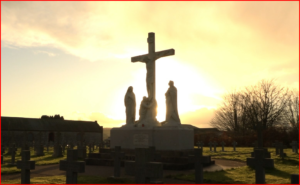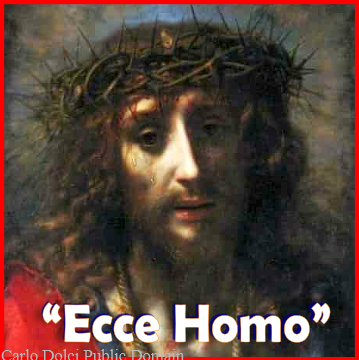In his description of the trial of Jesus in the Fourth Gospel, St John narrates how Pilate had Jesus brutally flogged:
And the soldiers wove a crown of thorns and put it on his head, and they dressed him up in a purple robe. They kept coming up to him, saying, “Hail, King of the Jews!” and striking him on the face. Pilate went out again and said to them, “Look, I am bringing him out to you to let you know that I find no case against him.” So Jesus came out, wearing the crown of thorns and the purple robe. Pilate said to them, “Here is the man!” (John 19:2-5).
From a human standpoint, the really powerful figure in this scene is Pilate – he has the power of life and death. However, from the perspective of St John, who knows that Jesus is the Incarnate Son of God (see John 1), the roles are actually reversed – Pilate is the really helpless individual; since he cannot see the truth literally staring him in the face, he remains trapped by the chains of sin and violence that implicate us all and that cannot easily be washed away (see Matthew 27:24). Even though humiliated and tortured, therefore, Jesus wields true power, for he is the Saviour of the world who freely gives of himself to break the stranglehold of death and make a new way of life possible.
For Christian faith, the death of Jesus on Calvary brings about a fundamental reversal in every aspect of life by revealing God’s unconditional love for us even amid the horrific violence on display. Thus the moment when evil appears to triumph is precisely the moment when the depths of God’s love become clear and the worst in us is overcome. The cross itself signals that reversal, as that instrument of torture and death is transformed into a sign and instrument of God’s forgiveness and love for everyone. As a consequence, no longer should the logic of ‘eye for eye and tooth for tooth’ hold sway in human relationships.

Henceforth, the only sacrifice pleasing to God is the sacrifice of praise that confesses the name of Jesus and imitates his self-giving love (see Hebrews 13:15).
What is clear to St John at the crucifixion is made still clearer by the resurrection, when the ongoing presence of the risen Christ is revealed. He is present in the Church, which is his body, and in the lives of believers who constitute that body (see 1 Cor 12:12-30). He is present, too, in the lives of the poor, the broken, the marginalised, the crucified of every time and place, for as the last judgment scene of Matthew’s Gospel makes very clear, he identifies with them in a very special way (see Matthew 25:31-46). In this light, it is clear to Christian faith that the story of Jesus Christ continues today, so that Pilate’s immortal phrase – ecce homo – can be understood as a pointer to his identification with every human being and to his solidarity with all the outcasts and rejects of society.
The Gospels thus challenge each of us to be truly Christ-like, truly Christian, in every aspect of our lives. There is no shortage of opportunities for such witness amid the acute difficulties faced by so many as a result of poverty, violence and war, and climate change, all of which are huge contributors to the homelessness which pervades our world and brings so many migrants and refugees to our shores.
How we respond to all such crises defines our lives, for in every instance, we are faced with a fundamental choice: do we opt for Pilate’s way or the way of Christ?
Joe Egan SMA

